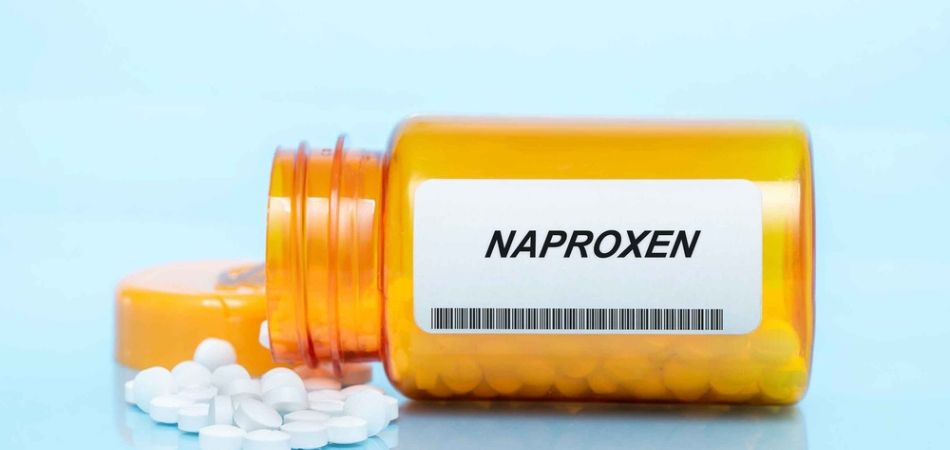Last Updated:
October 27th, 2025
Every one of us has to deal with unexpected aches and injuries at some point, which is why we keep over-the-counter painkillers on hand. They give us a straightforward solution for most types of pain and discomfort.
Yet many of us don’t fully comprehend the risks involved with cross-using painkillers like naproxen with alcohol. Understanding these dangers is a crucial step in protecting your health and safeguarding progress on the recovery journey.
What is naproxen?
Naproxen is a nonsteroidal anti-inflammatory drug (NSAID) prescribed to ease pain and reduce inflammation. It is commonly used for conditions such as arthritis, tendonitis, muscle aches, and menstrual cramps. Naproxen is available in prescription strength or lower doses over the counter for some treatments of period pain. It can be found under brand names such as Naprosyn, Stirlescent, or generic naproxen tablets.
Like other NSAIDs, naproxen works by blocking enzymes that trigger inflammation in the body. While this makes it effective for pain management, naproxen can also irritate the stomach lining, thin the blood, and increase strain on the digestive system.
Though it is often thought of as a routine painkiller, use of naproxen is not completely risk-free. Some of its side effects can become dangerous when taken frequently or in high doses, and its dangers are amplified if alcohol is also in your system.
How does naproxen interact with alcohol?
Taken individually, both alcohol and naproxen share some side effects that can impair your body. Both of them affect your stomach lining and the way you digest food, for example. When both substances are in the body, the results can actually compound, or multiply to a dangerous extent.
The NHS states that low doses of alcohol and naproxen are not a serious threat, but some of the interactions include:
- Heightened irritation in the stomach and digestive tract
- Make internal bleeding more likely
- Increase the chance of ulcers and long-term gastrointestinal issues
- Put extra strain on the liver and kidneys
This means that a single night of drinking while taking naproxen could leave you feeling far more unwell than expected, while repeated mixing can lead to long-term complications.
The health risks of mixing naproxen and alcohol
Taking higher doses of naproxen and alcohol will carry significant health risks. Most people keep some form of painkiller in their household, and may easily overlook the dangers of drinking after they’ve taken one.
Some of the main risks in higher mixed dosages include:
- Gastrointestinal bleeding: Both alcohol and naproxen cause impairments to your digestive system. Alcohol increases acid levels in the body, while naproxen can simultaneously thin the stomach lining. Together, they can cause ulcers or potentially life-threatening bleeding in your digestive tract.
- Liver and kidney damage: As both substances are processed by the liver, combining them increases the workload on this vital organ, potentially contributing to liver disease.
- Reduced alertness: Alcohol can make the side effects of naproxen, like dizziness or drowsiness, more intense, creating risks in regular activities like driving or operating machinery at work.
Who is most at risk from mixing naproxen and alcohol?
While any person who mixes alcohol with naproxen can face potential harm, there are certain groups at greater risk. You may be more vulnerable if:
- You’re over 60 years old: While kidney problems can start at any age, research shows that those over the age of 60 are more likely to have kidney disease, making the combined effects more harmful.
- Your consumption of alcohol is frequent or heavy: Regularly drinking to excess (above 14 units per week) is placing great strain on your liver and digestive system. Taking naproxen alongside this will increase the chance of bleeding.
- You suffer from asthma: In some asthma sufferers, research has shown that NSAIDs can cause bronchospasms and nasal obstruction. These can start as respiratory tract infections, which, left untreated, can potentially be life-threatening.
- You’re taking other medications: If you’re regularly taking medicines that thin your blood, other NSAIDs, or antidepressants, there can be further interactions with alcohol and naproxen.
If you fall into one or more of these categories, it is essential to speak with your doctor, GP or healthcare provider to avoid dangerous interactions. They may suggest other options that can be safer in the long term.
What are safer alternatives for pain management?
If you drink alcohol regularly or are worried about the risks of combining it with naproxen, it’s worth exploring other methods of managing pain. Speaking with your healthcare provider, they may suggest some of these options for a safer way to manage pain and put less pressure on your system.
Some possible alternatives can include:
- Paracetamol (acetaminophen): Generally regarded as gentler on the stomach than NSAIDs, paracetamol may be suitable for occasional pain relief. However, it still carries the risk of liver damage, particularly if combined with heavy alcohol consumption.
- Topical NSAIDs: Anti-inflammatory creams and gels (such as those containing diclofenac) are applied directly to the skin. Because they work locally rather than passing through the digestive system, they place less stress on the stomach and liver compared with oral tablets.
- Physical therapy and gentle exercise: For ongoing or chronic pain, methods like physiotherapy, yoga, or swimming can help reduce discomfort, strengthen the body, and improve mobility without involving medication.
- Heat and cold therapy: Hot water bottles, heating pads, or ice packs can be surprisingly effective in easing inflammation, swelling, and muscle pain, particularly when symptoms are mild to moderate.
No matter which option you choose, it’s vital to follow instructions carefully and never assume that a medicine is harmless simply because it can be bought without a prescription.
How to seek help if alcohol is interfering with your medication
If you’ve been drinking while also taking medications like naproxen, it may be a sign to make changes around your drinking. While naproxen itself is not considered addictive, alcohol’s potential for dependence is well-researched, and its influence on your overall health should not be overlooked.
Some warning signs that drinking is disrupting your medication use include:
- Continuing to drink despite experiencing side effects or being advised not to by a doctor
- Using painkillers after drinking in an attempt to “cancel out” or manage the effects
- Forgetting doses or losing track of how much medication you’ve taken
- Feeling defensive, anxious, or irritable when someone brings up your alcohol use
Mixing alcohol with naproxen amplifies the already heavy risks of alcohol misuse. If you find it difficult to cut back or feel that drinking is taking control, reaching out for support is the most vital step you can take.
A GP, doctor, or addiction specialist can help you contextualise the risks and advise you on the next steps to take. Healthcare providers can connect you with treatment when you need it. If you can address the problem early, your health is better protected and unhealthy patterns can be broken before they become embedded.
I want to speak to someone about my addiction
If alcohol is putting your health at risk, now is the time to reach out for help. You don’t need to wait until the situation escalates; support is available today.
Taking the first step can feel daunting, but you won’t be doing it on your own. At Linwood House, we specialise in treatment for alcohol and drug addiction. Contact UKAT today and begin moving towards the future you want, free from addiction.
(Click here to see works cited)
- NHS Choices, NHS, www.nhs.uk/medicines/naproxen/common-questions-about-naproxen
- “Pain Medicines and Kidney Disease.” National Kidney Foundation, 14 June 2025, www.kidney.org/kidney-topics/pain-medicines-and-kidney-disease.
- NHS Choices, NHS, www.nhs.uk/live-well/alcohol-advice/the-risks-of-drinking-too-much/
- Picado C. Mechanisms of aspirin sensitivity. Curr Allergy Asthma Rep. 2006 May;6(3):198-202. doi: 10.1007/s11882-006-0035-2. PMID: 16579869.



